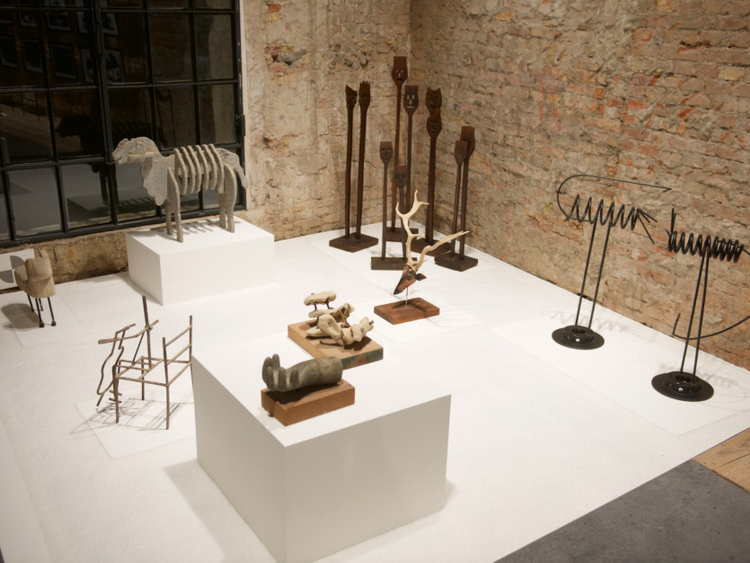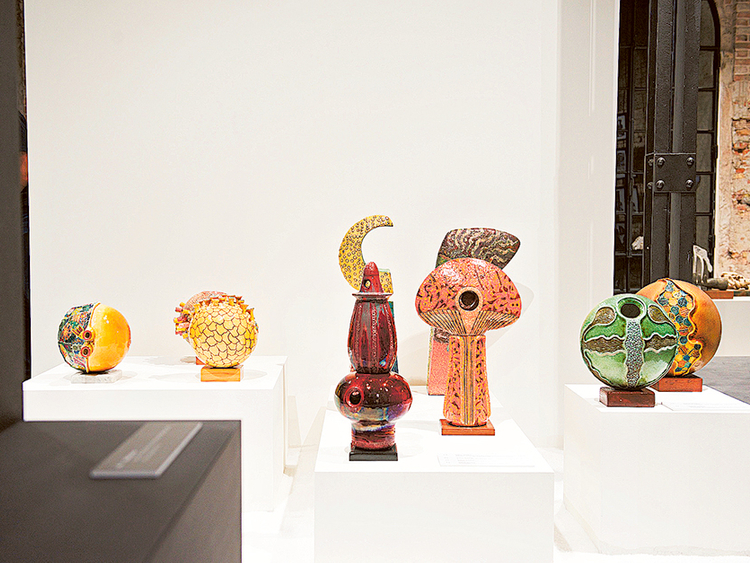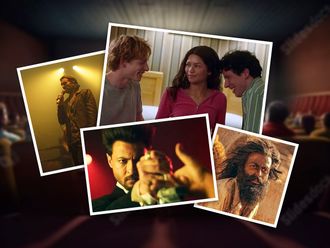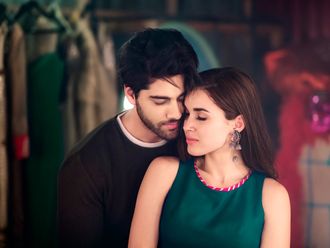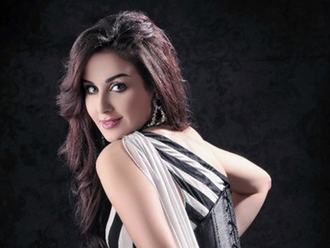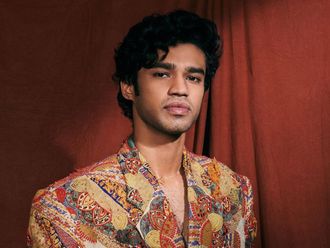
Uncovering stories that deserved to be told. This is what the National Pavilion showcasing UAE art does at the Venice Biennale. Drawing upon extensive historical research, curator Shaikha Hoor Al Qasimi spans the past and present, offering a diverse assemblage of work by key figures in UAE’s history of the arts.
The exhibition titled “1980–Today: Exhibitions in the United Arab Emirates” presents a selection of works from different decades, highlighting the emergence of art practices in the UAE. With over 100 diverse works featured, the show aims to create dialogues and explore the emergence of contemporary art in the UAE over the past 40 years.
Shaikha Hoor’s two-year research for the show relied heavily on the public archives of the Emirates Fine Arts Society (EFAS) — a trove of English and Arabic books on visual arts, theatre, and literature, as well as catalogues, photo albums and copies of “Al Tashkeel”, EFAS’s newsletter published since the 1980s. The EFAS is a non-profit association formed in 1980 in Sharjah, and has long served as a galvanising incubator for UAE’s arts scene.
“The opportunity to curate the National Pavilion of the UAE has allowed me to reflect on and honour a significant period of UAE’s art history,” says Shaikha Hoor. “Looking back at exhibitions from the 1980s, I have come across a number of interesting artworks, mainly sculptures and paintings by now-established artists, as well as works by lesser known ones. It is important to state here that the focus is on the artworks, not the artist. My aim is to show the diversity of art practices, and the history of the arts scene in the UAE at this period in time.”
The exhibition features works by 15 Emirati artists: Ahmed Al Ansari, Moosa Al Halyan, Mohammed Al Qassab, Abdul Qader Al Rais, Abdullah Al Sa’adi, Mohammed Abdullah Bulhiah, Salem Jawhar, Mohammed Kazem, Dr Najat Meky, Abdulraheem Salim, Ahmed Sharif, Hassan Sharif, Obaid Suroor, Dr Mohamed Yousif and Abdulrahman Zainal.
The 56th International Art Exhibition at the Venice Biennale, which opened on May 9, will end on November 22, 2015, and is held at the Giardini and the Arsenale. The UAE’s pavilion is located at the Arsenale-Sale d’Armi.
The research for the pavilion involved archives of newspaper articles, artists’ writings and catalogues as well as interviews with artists and cultural practitioners. Reflecting personal and geopolitical trajectories, the research focused on the underexposed historical record and evolving practices of some of UAE’s most important modernist and contemporary artists.
“Over the last decade, the UAE arts scene has experienced a surge in international recognition and appreciation. However, many are still not aware of the depth and diversity of our artists, who have been working decades longer than the present art boom,” notes Shaikha Salama Bint Hamdan Al Nahyan, founder of the Salama Bint Hamdan Al Nahyan Foundation, which commissioned the pavilion. “This exhibition represents an opportunity to document, share, and expand upon a key period for the country’s arts history.”
The pavilion is supported by the UAE Ministry of Culture, Youth and Community Development and is UAE’s fourth national pavilion at the Venice Biennale.
Shaikha Salama goes on express delight to be working with curator Shaikha Hoor. “Thanks to her vision and leadership, we are able to share essential works from this key period in the UAE’s arts scene and also to build links for future generations. I applaud her contributions to the development and advancement of the larger discourse on the arts from the region.”
A publication including writings and articles on the arts scene in the UAE since the 1980s as well as some personal memoirs from a number of artists are presented alongside the exhibition.
According to the curator, “Reflecting our generation’s collective obsession with memory, many recent exhibitions have been conceived to look at the past in order to reflect on the present. For these archival exhibitions, curators travel the world to discover overlooked artists and arts scenes, institutions invest in research, gathering material, and publishing texts. But how do we connect all the information?”
“This exhibition — and its accompanying publication — invites viewers to make connections directly between objects, historical archives, and the collective memory they represent. The resulting discourse is both personal and collective, and marks the beginning of a much more detailed and intensive research project.”
Subject and theme
The exhibition design creatively represents its subject and theme. Inspired by historic exhibitions in the UAE throughout the 1980s, the National Pavilion is structured to follow the aesthetic experience and encourage connections between works. In addition to thematic groupings, some works are arranged to highlight elements of an individual’s practice, while others are paired to create complimenting and contrasting dialogues between works.
Rather than following a didactic chronology, the exhibition creates the sense of wandering through dense collections in conversation with one another. The works, many on loan from institutions and private collections as well as from the artists themselves, demonstrate a juxtaposition of conceptual and formal approaches, time periods and media.
The selection of pieces focuses on sharing fundamental stages of the artists’ careers as well as that of the UAE arts scene collectively.
Abdullah Al Sa’adi says his thematic and formal concerns all along have been exploring nature and rural life and documenting landscapes through drawing, painting and collecting objects from nature such as stones and bones while travelling and living in the countryside, such as “Camar Cande’s Journey” (2010-2011) and the sweet potato project (various).
Al Saadi studied Japanese art from 1994 to 1996. “Staying in Japan touched my heart and soul and has inspired my practice. Living in Japan helped me see UAE’s nature in a new light. For example, I saw stones as an art in stone gardens in Japan and that inspired me to look differently at the stones and rocks we have in the mountains and rural areas of the UAE. The colours of Japan are also fascinating and inspiring. I got to experience and appreciate Japan’s four seasons with their distinct colours. I also began drawing handscrolls while in Japan,” he says.
At the National Pavilion, Dr Najat Meky’s work represents that of one of the frontrunners on the UAE arts scene. About her recollections of working in cultural and art organisations in the UAE and how it has influenced her art, she says: “The Emirates Fine Arts Society, in its initial years, played a prominent role in establishing the UAE arts scene. It provided a platform for locally based artists to come together, exhibit and exchange ideas. The organisation supported artists through exhibitions, workshops, lectures, etc. These exhibitions and experiences created a spirit of competition that motivated and challenged the artists to try different forms of art and develop different practices and styles.
“Through my involvement with the Society, I was able to participate in many local and regional competitions and workshops which enabled me to explore different aspects of the world of art and gain exposure to different practices and ideas. All this served as inspiration for the development of my practice.”
About the impact of women artists on the future of arts in the UAE, she says: “Both female and male artists have an important role in the development of art in the UAE. We have participated in exhibitions and competitions and represented the UAE in regional and international events.”
Dr Meky has a word of advice for the younger generation of artists in the UAE: “I think that the support and opportunities emerging artists get from organisations, institutions and government entities nowadays are great and will help pave the way for their careers. I encourage young artists to work hard, pursue opportunities and not give up despite any difficulties they face, as the arts industry requires a lot of patience and effort!”
N.P. Krishna Kumar is a freelance writer based in Dubai.
National Pavilion UAE at la Biennale di Venezia
Initiated in 2008, the National Pavilion UAE seeks to endorse UAE’s contemporary art practices on an international platform and provide a foundation to support the nation’s diverse and developing cultural scene.
The UAE has been participating in every edition of the International Art Exhibition since 2009, and began participating in the International Architecture Exhibition in 2014.
The office also organises the Venice Internship, offering a range of opportunities to young Emiratis keen to engage with culture and arts at the highest international level through a one-month internship on-site in Venice. These interns manage the exhibition and participate in a rigorous educational programme.
The National Pavilion UAE la Biennale di Venezia is commissioned by the Salama Bint Hamdan Al Nahyan Foundation and supported by the UAE Ministry of Culture, Youth and Community Development. Established in 2010, the Salama Bint Hamdan Al Nahyan Foundation’s mission is “to invest in the future of the United Arab Emirates by investing in its people”. It develops and supports strategic initiatives in the areas of education; arts, culture, heritage; and health.



